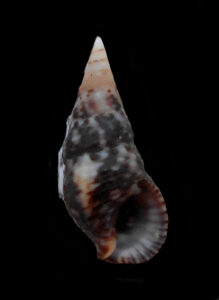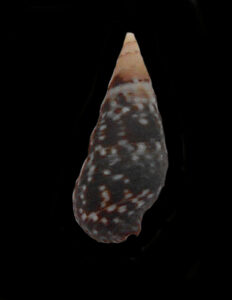Menkei Cerith Shell, Cerithium menkei

 Menkei Cerith Shell, Cerithium menkei. Shell collected off the beach in the greater Los Cabos area, Baja California Sur, May 2006. Size: 1.4 cm (0.6 inches) x 0.6 cm (0.2 inches). Identification courtesy of Bob Hillis, Ivins, Utah.
Menkei Cerith Shell, Cerithium menkei. Shell collected off the beach in the greater Los Cabos area, Baja California Sur, May 2006. Size: 1.4 cm (0.6 inches) x 0.6 cm (0.2 inches). Identification courtesy of Bob Hillis, Ivins, Utah.
Phylogeny: The Menkei Cerith Shell, Cerithium menkei P.P. Carpenter, 1857, is a gastropod mollusk that is a member of the Cerithiidae Family of Cerith Shells. The genus Cerithium is one of forty-seven genera in this family, and there are one hundred fifty-two species in this genus. They are known in Mexico as Cerithium de Menkei. This shell is named in honor of the German malacologist Karl Theodore Menkei.
Description: The Menkei Cerith Shell is small and stout. It consists of seven to eight whorls. The exterior may be mostly smooth or it may be marked with spiral and length-wise lines, yielding a crisscross pattern of nodes over the surface. The aperture is medium in size. The exterior color ranges from light to dark gray, with varying amounts of brown and/or white blotching. The interior may be white, bluish, or dark brown. The outer lip of the aperture often has a white rim. The bottom inside edge of the aperture is also white. Menkei Cerith Shells reach a maximum of 1.6 cm (0.6 inches) in length and 0.7 cm (0.3 inches) in height.
Habitat and Distribution: Menkei Cerith Shells are found on, or under, rocks within the intertidal zone and to depths up to 5 m (15 feet). They are a subtropical to tropical Eastern Pacific species that are found in Mexican waters of the Pacific Ocean from Magdalena Bay, Baja California Sur south to Guatemala. They are found in the Sea of Cortez from Mulegé to Cabo San Lucas, Baja California Sur.
Ecology and Behavior: Menkei Cerith Shells are opportunistic grazers that feed primarily on micro algae and detritus. They are gonochoric. The males place packets of sperm (spermatophores) on the females which the females utilize when they are ready to lay their eggs. The eggs are laid in gelatinous string-like masses. There is no mention in the available literature of them engaging in any types of parasitic, commensal, or symbiotic relationships. From a conservation perspective they have not been formally evaluated however they are fairly common with a relatively wide distribution and should be considered to be of Least Concern.
Synonyms: Cerithium (Thericium) menkei and Cerithium interruptum.